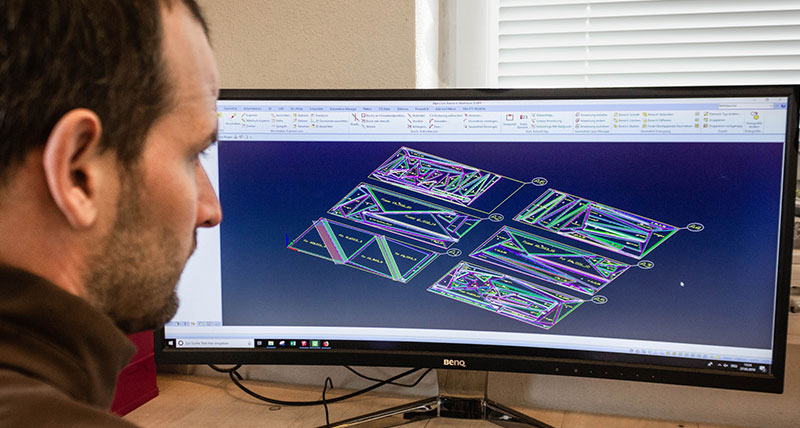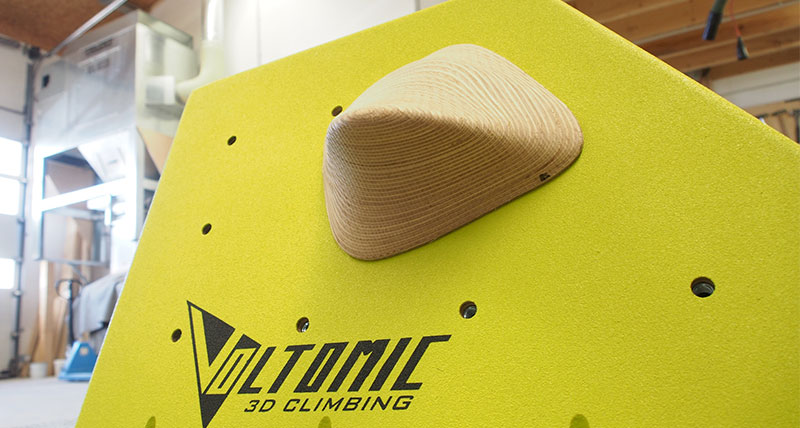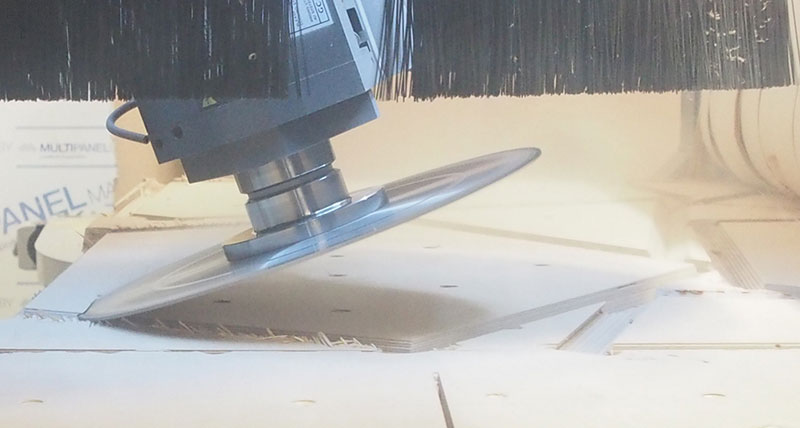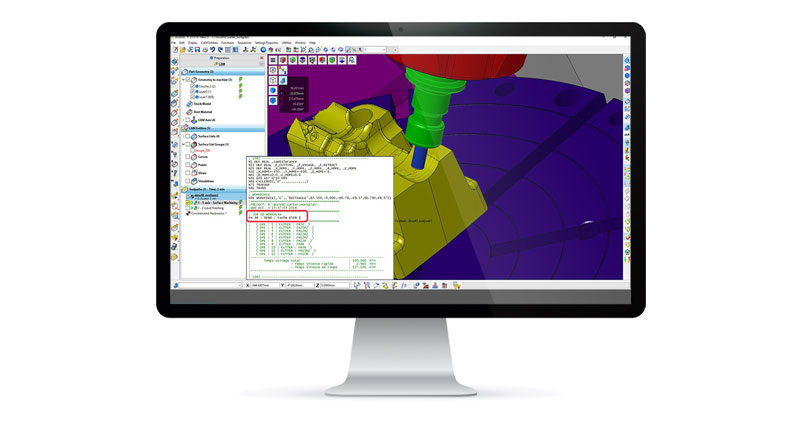ALPHACAM key in Voltomic’s climb to success
A new Olympic sport next year highlights importance of 5-axis nesting
Contact us

A company specialising in manufacturing components for climbing walls makes full use of saw blades, end mills, drills and other tools as part of a complex and sophisticated machining process, just a year after investing in their first CNC machine tool and ALPHACAM software.
Voltomic’s wall structures add a new dimension to climbing and bouldering. As well as building new climbing walls the company can construct routes on pre-existing walls. “It’s possible to create a completely new wall shape, fast and comfortably, giving customers maximum variety,” says Joint Managing Director Stephan Müller.
 The base material for their applications is multiplex birch panels that are bonded with a PU polyurethane reactive adhesive before being screwed together. Until about a year ago the team still did everything manually, including cutting the birch panels, along with the large prism climbing features (known as volumes) that are attached to the wall, mini boards, profiles and bolder walls, with portable circular saws, orbital sander and cordless screwdrivers.
The base material for their applications is multiplex birch panels that are bonded with a PU polyurethane reactive adhesive before being screwed together. Until about a year ago the team still did everything manually, including cutting the birch panels, along with the large prism climbing features (known as volumes) that are attached to the wall, mini boards, profiles and bolder walls, with portable circular saws, orbital sander and cordless screwdrivers.
How different today. Stephan and his brother Thomas realised that they needed to take a new technology-focused approach for the company to grow and have now implemented a 5-axis nesting process on their recently acquired Format-4 Profit H 500 MT machine tool, programmed with ALPHACAM software. “The times when we went through a handful of portable circular sawblades every day to machine the birch panels are well and truly over,” he says.
It also means they can now offer a vast number of different volume shapes. In addition to the now 1,500 standard shapes – prior to investing in the Format-4 and APHACAM they could only 50 – the company can easily configure almost any new shape.
Stephan uses Sketchup to initially model new volumes from planar sections. Then ALPHACAM enters the equation, with its STL Hans extension for transforming STL files into a compatible CNC format identifying those planar sections within the 3D space and preparing them for panel generation. The ALPHACAM panel macro then automatically creates the panels to the specified thickness, including connectors and the required mitres, before splitting them into individual component files.
ALPHACAM’S Automation Manager compiles production jobs from any number of those components. “After that it only needs a mouse click to start machining. The process includes the high-performance nesting tool arranging them for optimum material yield (saving up to 15 per cent in material, compared with the former process) and cycle times. It also has to take a sophisticated perforation pattern into account.
“The 5-axis CNC machine then starts by drilling what will become the volumes’ outsides – this includes blind holes for sinking screws. After this, the panel is rotated for the rest of the machining.”
 During the process, the saw blade, end mill, drill and other tools are all applied as part of what Stephan calls a “sophisticated machining process.” He says ALPHACAM identifies important details. “For example, as part of 5-axis formatting, around 0.5mm is left at the bottom, guaranteeing that even the smallest parts can be safely machined without slipping out of place. The final cut is only made once all CNC machining has been completed. A number is engraved into each of the 20 to 30 parts from one nest, making it clear where each one belongs in the final assembly.”
During the process, the saw blade, end mill, drill and other tools are all applied as part of what Stephan calls a “sophisticated machining process.” He says ALPHACAM identifies important details. “For example, as part of 5-axis formatting, around 0.5mm is left at the bottom, guaranteeing that even the smallest parts can be safely machined without slipping out of place. The final cut is only made once all CNC machining has been completed. A number is engraved into each of the 20 to 30 parts from one nest, making it clear where each one belongs in the final assembly.”
The complete panel machining process takes between 45 minutes and one hour at Voltomic’s premises in Rosenheim, Bavaria…and the company’s choice of end mill ensures machine downtime for changing cutting tools is kept to a minimum. Formatting multiplex material quickly wears out hardened metal blades, so Voltomic use diamonds. “When we purchased the Format-4, cutting tool manufacturer Aigner recommended Konstantin Mini, an end mill using replaceable milling and drilling diamond blades. According to Aigner, the downtime when cutting applied multiplex panels is reduced by up to 30 per cent with diamond blades, compared to hardened metal tools.”
Concluding, Stephan Müller says: “ALPHACAM is our paramount software tool. Its high-performance nesting optimises the arrangement of many individual parts in the panels and generates all the required CNC programs. The combination of this 5-axis nesting on the Format-4 Profit gives complete rational machining through sophisticated strategies.
“This will become increasingly important in the near future. We currently produce around 5,000 climbing wall volumes a year, but production figures are expected to grow as climbing will become an Olympic sport in 2020.”
Voltomic’s wall structures add a new dimension to climbing and bouldering. As well as building new climbing walls the company can construct routes on pre-existing walls. “It’s possible to create a completely new wall shape, fast and comfortably, giving customers maximum variety,” says Joint Managing Director Stephan Müller.
 The base material for their applications is multiplex birch panels that are bonded with a PU polyurethane reactive adhesive before being screwed together. Until about a year ago the team still did everything manually, including cutting the birch panels, along with the large prism climbing features (known as volumes) that are attached to the wall, mini boards, profiles and bolder walls, with portable circular saws, orbital sander and cordless screwdrivers.
The base material for their applications is multiplex birch panels that are bonded with a PU polyurethane reactive adhesive before being screwed together. Until about a year ago the team still did everything manually, including cutting the birch panels, along with the large prism climbing features (known as volumes) that are attached to the wall, mini boards, profiles and bolder walls, with portable circular saws, orbital sander and cordless screwdrivers.How different today. Stephan and his brother Thomas realised that they needed to take a new technology-focused approach for the company to grow and have now implemented a 5-axis nesting process on their recently acquired Format-4 Profit H 500 MT machine tool, programmed with ALPHACAM software. “The times when we went through a handful of portable circular sawblades every day to machine the birch panels are well and truly over,” he says.
It also means they can now offer a vast number of different volume shapes. In addition to the now 1,500 standard shapes – prior to investing in the Format-4 and APHACAM they could only 50 – the company can easily configure almost any new shape.
Stephan uses Sketchup to initially model new volumes from planar sections. Then ALPHACAM enters the equation, with its STL Hans extension for transforming STL files into a compatible CNC format identifying those planar sections within the 3D space and preparing them for panel generation. The ALPHACAM panel macro then automatically creates the panels to the specified thickness, including connectors and the required mitres, before splitting them into individual component files.
ALPHACAM’S Automation Manager compiles production jobs from any number of those components. “After that it only needs a mouse click to start machining. The process includes the high-performance nesting tool arranging them for optimum material yield (saving up to 15 per cent in material, compared with the former process) and cycle times. It also has to take a sophisticated perforation pattern into account.
“The 5-axis CNC machine then starts by drilling what will become the volumes’ outsides – this includes blind holes for sinking screws. After this, the panel is rotated for the rest of the machining.”
 During the process, the saw blade, end mill, drill and other tools are all applied as part of what Stephan calls a “sophisticated machining process.” He says ALPHACAM identifies important details. “For example, as part of 5-axis formatting, around 0.5mm is left at the bottom, guaranteeing that even the smallest parts can be safely machined without slipping out of place. The final cut is only made once all CNC machining has been completed. A number is engraved into each of the 20 to 30 parts from one nest, making it clear where each one belongs in the final assembly.”
During the process, the saw blade, end mill, drill and other tools are all applied as part of what Stephan calls a “sophisticated machining process.” He says ALPHACAM identifies important details. “For example, as part of 5-axis formatting, around 0.5mm is left at the bottom, guaranteeing that even the smallest parts can be safely machined without slipping out of place. The final cut is only made once all CNC machining has been completed. A number is engraved into each of the 20 to 30 parts from one nest, making it clear where each one belongs in the final assembly.”The complete panel machining process takes between 45 minutes and one hour at Voltomic’s premises in Rosenheim, Bavaria…and the company’s choice of end mill ensures machine downtime for changing cutting tools is kept to a minimum. Formatting multiplex material quickly wears out hardened metal blades, so Voltomic use diamonds. “When we purchased the Format-4, cutting tool manufacturer Aigner recommended Konstantin Mini, an end mill using replaceable milling and drilling diamond blades. According to Aigner, the downtime when cutting applied multiplex panels is reduced by up to 30 per cent with diamond blades, compared to hardened metal tools.”
Concluding, Stephan Müller says: “ALPHACAM is our paramount software tool. Its high-performance nesting optimises the arrangement of many individual parts in the panels and generates all the required CNC programs. The combination of this 5-axis nesting on the Format-4 Profit gives complete rational machining through sophisticated strategies.
“This will become increasingly important in the near future. We currently produce around 5,000 climbing wall volumes a year, but production figures are expected to grow as climbing will become an Olympic sport in 2020.”
Photos courtesy of Voltomic and BM / Christian Närdemann.
Production software
Offering a range of CNC simulation software, factory automation solutions and computer-aided manufacturing (CAD CAM) packages specified for different production methods,...
